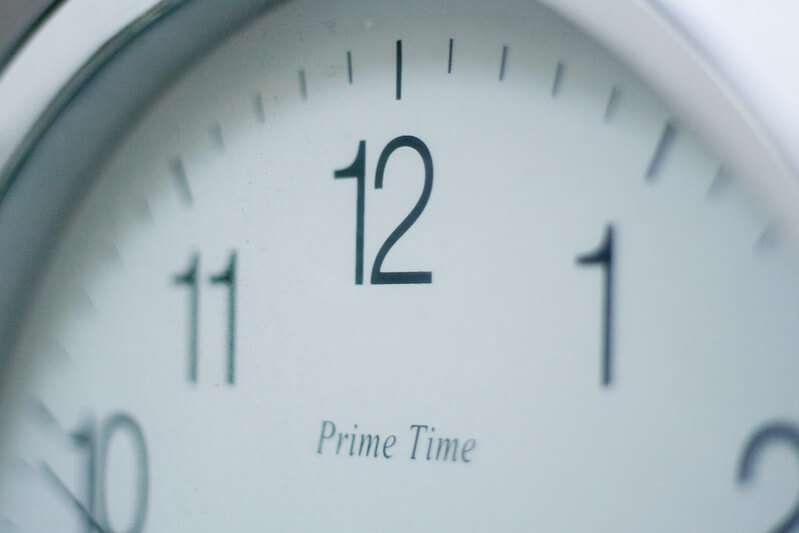Business Blog Schedule: Best Time to Blog?
If you’re trying to create an editorial calendar to keep your business blogging on schedule, there are two tricky things you need to master: coming up with new content ideas and figuring out how often to blog.
The optimal blogging frequency and the best times to blog will vary from business to business, but the following tips and resources will help you discover the best publishing timetable for you.

Blogging Frequency Best Practices
Although it takes some experimentation to find the best publishing schedule, there are a few general guidelines that always apply:
1. Publish a new blog post at least once a week
2. Be consistent and always publish on the same day
3. Focus on creating high-quality content
According to this article on Rock Content, publishing at least one new blog post a week is optimal because it helps maintain good relationships with customers, attract natural search traffic, and avoid burnout from writing too often.
Of course, you can and should experiment to find out what works best for your company, goals, and readers.
Once you’ve discovered the best times to blog, being consistent with your publishing schedule also increases SEO value and encourages readers to come back regularly for more.
Figuring Out How Often to Blog
So should you stick with publishing once a week or play around with several times a week, every day, or even multiple times per day?
Before you start experimenting with your business blogging frequency, there are a couple things to consider to help you narrow down your options. This article from MarketingInsiderGroup names the most important: your goals and what your audience wants.
These two factors are the biggest considerations in figuring out how often to blog. For example, if your goal is to become a cutting edge information resource, you might want to post shorter articles more often, even a couple times a day like major news websites. But if your main audience is mostly interested in technical or behind-the-scenes details, you’ll probably publish longer articles less often.
So the first step to determining your ideal blogging frequency is to find the perfect balance of what you want and what your audience wants.
The next step is to fine-tune your blogging schedule by asking yourself the important questions listed in this article from Pepper Content:
- Can you keep this schedule consistently?
- Can you always publish high-quality content at this rate?
- Will you have enough content for this schedule?
If you answer “No” to any of these questions, adjust frequency until you can say “Yes.” Remember it’s okay to tone down or ramp up your blogging frequency as your goals, resources, and audience desires change over time.
Lastly, before you finalize how often to blog, consider ways to avoid burnout and build them into your editorial calendar. This could mean blogging less often, accepting guest posts, assigning blogging responsibilities to a team instead of one person, and anything else you can think of.
Experimenting with How Often to Blog
Start with what you believe to be your ideal blogging frequency, or the baseline of one post per week. After two to four weeks, add one more post per week if you can handle it and continue for the same time period. Then compare results.Once you’ve determined your business goals and audience needs, answered the important questions, and planned for burnout, it’s time to experiment.
The most important results to look at include:
- unique visitors
- pages per visit
- visitor to subscriber/lead ratio
- lead to customer ratio
- time on site
If these numbers are promising, you can repeat the experiment until you find your cap, either what you cannot consistently do or what your audience doesn’t seem to like.
Best Times to Blog for Businesses
Dan Zarrella, a social media scientist at HubSpot, constantly researches what’s working and what’s not online. According to data he published in this post on his blog, this post on ProBlogger, and this infographic from KISSMetrics:
- the best time to blog for pageviews is Monday between 8 and 11 am
- the best time to blog for increased engagement is Saturday between 8 and 11 am
He also presents research into the best times to tweet and share your blog posts on Facebook for maximum reach.
The actual day and time of publishing a blog post is important because it affects how much the post will be seen online. Some other key takeaways from Dan Zarrella’s research include:
- Publishing in the morning (around 9am EST) leads to more Facebook shares
- Tweeting the post in the afternoon (around 4 pm EST) leads to more retweets
- Publishing on Friday, Saturday, and Sunday leads to more Facebook shares
- Publishing on Friday can also lead to more retweets
- Increasing publishing frequency leads to more traffic and incoming links
What It All Comes Down To
So what does all this research and theory mean for you?
Publish in the morning between 8 and 11am on multiple days, specifically Monday, Friday, and Saturday. Share your posts on Facebook in the morning and on Twitter in the afternoon to stimulate the most social sharing.
Don’t forget to experiment with publishing on other days of the week, at different times of the day, and more than once per day.
Keep in mind that the best time to blog varies by your audience. If they are mostly business people, blogging on Saturday probably won’t work very well. If they are mostly located in a certain time zone, schedule your posts to publish in their mornings, not yours.
How often do you blog? Have you experimented and found what works for you? We’d love to hear your thoughts in the comments!

Comments (0)